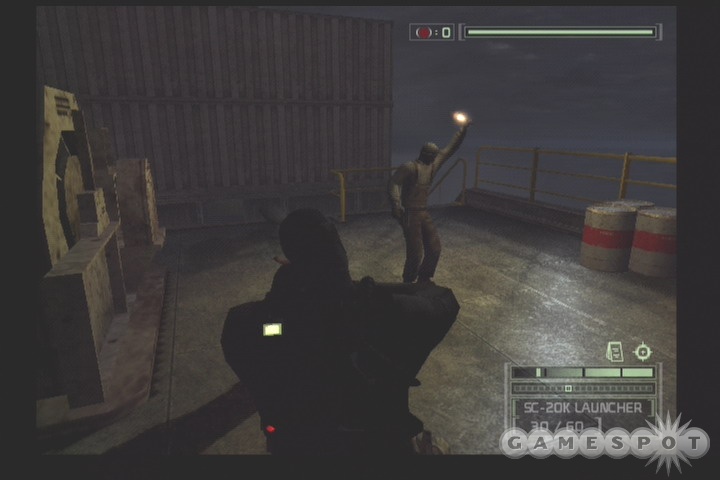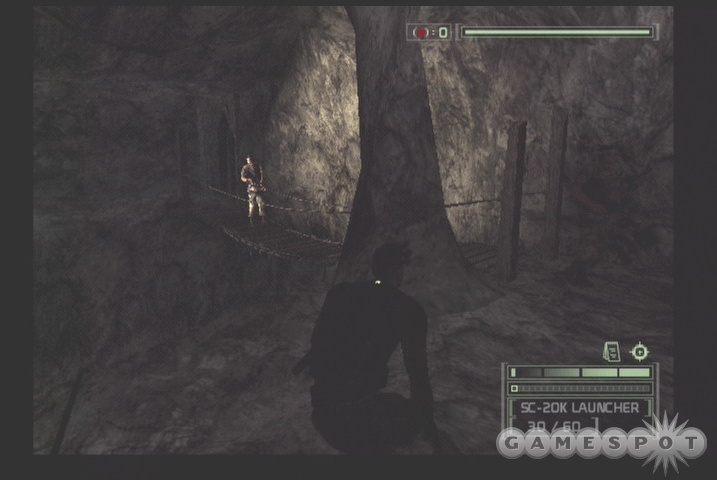Tom Clancy's Splinter Cell Chaos Theory Q&A
Ubisoft Montreal producer Andre Roy discusses the PS2 version of Sam Fisher's latest action adventure.
Currently scheduled for release toward the end of this month, Splinter Cell Chaos Theory is the third game in Ubisoft's Tom Clancy-inspired stealth action series. Versions of the game are in development for the PC and all current-generation consoles, as well as for the N-Gage and various mobile platforms. We recently spoke with Ubisoft Montreal producer Andre Roy to find out how the PlayStation 2 game will play to that console's strengths, and how it will compare to the Xbox version.
GameSpot: How was development on the game approached given how ambitious the Xbox game is?

Andre Roy: Just like with the Xbox version, we were extremely ambitious. We knew that the PS2 hardware had never been exploited the way it should have been and could have been from a graphical standpoint. So we told ourselves that if the Xbox version was taking graphics where no one had before, then why not go ahead and push ourselves in the same way for the PS2 (we like internal challenges here in the Montreal studio). Also, we really wanted to address the gameplay experience for a PS2-specific audience, meaning that we wanted the PS2 owner to enjoy the game and discover the Splinter Cell franchise from a PS2 perspective.
GS: How much research and development was required to get the PS2 game engine to where it is?
AR: Well, it took us almost a year to get it where it is now. Graphically speaking, we invented what we call "geo-texturing" (materials that are displayed in real 3D), we developed the specular effect (light reflection on specific materials), the refraction effect (visual distortion in water and glass), and created a new way of displaying the water. But we didn't limit ourselves to that innovation--we also introduced the back-and-forth in-between split map, or what could be called the "load progress system," and also a dynamic loading system that allowed us to save on memory constraints.
GS: What did you learn from the experience? Was there anything surprising?
AR: We all learned that it takes more than just a talented team to achieve these amazing results--it takes complete team effort and dedication. The most surprising thing was the way the team managed to pull the entire thing together, with such a stunning final product. There weren't any glitches in the machine--just an incredibly devoted team of more than 100 girls and guys pushing themselves to deliver.
GS: How different is the PS2 game from the Xbox from both a technical and gameplay standpoint?
AR: From a technical standpoint, we had to work with a very different set of hardware that has its own constraints: memory, sound streaming, and no hard disc, just to name a few. Keeping this in mind, we decided to revisit all solo and co-op missions and make them PS2-specific. For example, in the co-op mode, technical issues arose early on when we tried to take the mode online, so we decided to focus exclusively on creating co-op for split-screen to deliver the best possible experience for PS2 gamers. In terms of the memory constraints, we decided to focus on shorter co-op missions--18 in all--each of which requires a reliable friend to complete, and each is guaranteed to keep you on the edge of your sofa. In terms of the solo missions, and again due to memory constraints, we focused on developing a more compact style of gameplay that sustains action throughout the game. For instance, if you decide to achieve your objective using the X pathway, or the Y or the Z one, you will always be confronted with something intense. There is no downtime in the PS2 version.
GS: How did you work to keep the multiplayer experience fresh despite the fact that many aspects of it were from the previous game?

AR: We added even more experienced people to the multiplayer development team (the versus mode). They knew exactly what they needed to do to keep the versus levels fresh and exciting, since we always learn a great deal from one production to another. And, of course, the all-new co-op missions deliver a completely new kind of multiplayer gaming experience for the Splinter Cell franchise.
GS: What's been the biggest challenge in working with the PS2 this time out and how did you overcome it?
AR: Biggest challenge...to fit everything on one disc! Joking aside, we really wanted the title to appeal to a PS2 crowd, to let everybody know that we are dedicated to making sure that the Splinter Cell brand distinguishes itself on all platforms.
GS: How much more performance do you think you could get out of the PS2?
AR: Well, with everything we did with it, we think the hardware might be overheating… We think we set a new standard for the PS2 and we already have internal teams trying to challenge us on it!
GS: What are you proudest of about the PS2 version of Chaos Theory?
AR: Everything, really--the graphics, the gameplay, the three different game modes...and, most importantly, the incredible achievement of the development team!
GS: Will you be including any PSP support? If not, is that something you'd consider for a future game?
AR: No, we are not supporting PSP on this one. For sure, we are always looking to improve on what we have done before, and PSP support is certainly an avenue to investigate in the future.
GS: Given your success with this current game, where do you think the series should go from here?
AR: Well, we want to get this game finished and out the door before we start dreaming once again...
GS: Have you considered a PS2-exclusive version of the game?
AR: Our focus with Splinter Cell Chaos Theory was to establish Splinter Cell as a cross-platform brand. We will have to see what the future holds for Sam Fisher.
GS: Thanks for your time.
For more information on the PS2 version of Tom Clancy's Splinter Cell Chaos Theory, check out our latest hands-on preview of the game.
Got a news tip or want to contact us directly? Email news@gamespot.com
Join the conversation